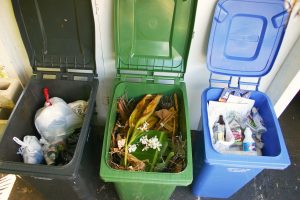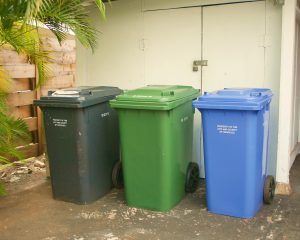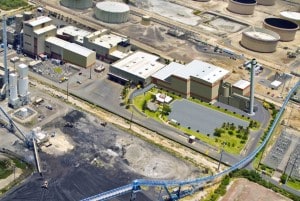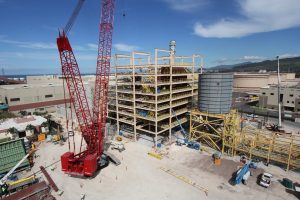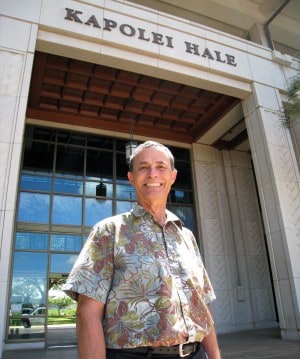In the Spotlight
Honolulu, HI’s Department of Environmental Services: Protecting Its Most Precious Resources
With a waste-to-energy facility, community outreach programs and the constant improvement of its waste and recycling programs, Honolulu, HI’s Department of Environmental Services focuses on taking the next step to a greener world.
Hawaii’s refuse collection can be dated back to the 1850s when the then-Hawaiian monarchy provided urban public services. Now, referred to as “opala” (the Hawaiian word for garbage), Honolulu’s trash is picked up by the Department of Environmental Services (ENV), which came into existence after a reorganization in 1998. Prior to that time, a small division within the Department of Public Works handled all of the refuse collection. Joined with the Division of Wastewater Management as well, the two divisions had close to 400 people in refuse and another 450 people in wastewater. When the reorganization occurred, both divisions were put under the new Department of Environmental Services. By doing this, more attention from the administration was now placed on the refuse issues as opposed to when they were part of Public Works, which primarily dealt with roads, drainage, etc.
Currently, 327 refuse employees and approximately 900 employees make up ENV, which includes the Environmental Quality Division, Wastewater Treatment & Disposal Division, Collection System Maintenance Division and the Office of Administrative Support. Servicing the entire island of Oahu—which is made up of the City and County of Honolulu— ENV does about 200,000 residential pickups a week. Refuse collection consists of green waste, household municipal solid waste, mixed recyclables and bulky item waste.
Moving to Curbside Recycling
According to Tim Steinberger, Director of ENV, the refuse division has seen a reduction of nearly 200,000 tons of waste in annual totals in the past couple of years due to residents spending less money, buying fewer products, which, in turn, constitutes less production of waste curbside. However, Steinberger points out that ENV has a waste-to-energy facility in the area that preferentially diverts refuse, sending the remainder to the landfill. As a result, the greatest reduction that ENV saw was at the landfill—at one time it was taking about 1,000 tons per day; now, it is down to about 400 to 500 tons per day. In addition, the department’s newly implemented curbside recycling program has taken a pretty good piece out of that as well. “With the economy coming back, we are probably going to see more MSW,” says Steinberger. “Ideally, what we would like to see occur is more recycling. I’m more concerned about growing the recycling program than about the revenue side.”
The journey to curbside recycling was not without its share of challenges. Originally, privatizing the program was a consideration; however, the department ran into a few issues when going in that direction. So, around 2002/2003, the transition was stopped until the concerns could be worked out. When the program was revisited in 2005/2006, it was determined that the department would take on the task—in other words, it would be a county function. As a result, the department purchased the appropriate bins—gray, blue and green—and distributed those to the participating residential areas. Says Steinberger, “One of the most notable changes that made this doable was going from manual collection to automated because at this point we were able to schedule the day that a particular colored bin would be picked up. We were also able to use the same trucks that we used for the regular MSW pickup, which helped a lot.”
Beginning automation collection in the 1990s, ENV has gone about as far as they can with it given the geography of Honolulu. “It’s an old city so we can’t get in and automate some areas because the streets are too narrow or there are dead end streets that require you to back up. In all, about 25,000 of our 200,000 stops are on manual collection,” states Steinberger. For those narrow streets, ENV has different size trucks they can drive into the street and do the pickup; then, they’ll back out. Steinberger says the only drawback is those 25,000 stops still on manual collection are not on the curbside recycling program. “That’s the next thing that we want to tackle.”
Before the curbside recycling collection program was started, recycling was typically a voluntary thing. ENV was in partnership with a private company and would put out community recycling bins at a shopping center or a school within a neighborhood so people could drop off their material. In turn, ENV would pay the private company to pick up the bins once they were full and take them to the recyclers; therefore, the recovery rate was not high. When the move was made to curbside collection, it became much more convenient for people because they didn’t have to travel to another place to get rid of their recyclables—they could just put it directly into a can. Although, ENV is still around 25 percent pickup, since the implementation, there has been a much higher return rate on recyclables. “There is still a lot of material that ends up at the H-POWER facility but we can separate out the recyclables—mostly metals and aluminum (the plastics generally get burned),” says Steinberger, who is constantly pushing the recycling goals higher. “We would like to push our percentage up to 30 percent over the next couple of years, so we have a pretty active public outreach program trying to get more people on board with this.”
Pickup Challenges
Some challenges ENV has encountered over the years have been the illegal dumping of bulky items. About six to seven years ago, only the urban Honolulu area received monthly bulky item pickup and the rural areas were on call. When the entire island of Oahu was placed on a monthly bulky item pickup schedule, there was a huge reduction in illegal dumping. With this program, a week is established once a month in which large items are collected, such as couches, mattresses, refrigerators, etc. Where the department runs into problems is dealing with areas that have a lot of low-rise condos that may be primarily rentals. The first day of the month is when people tend to move and many times the pickup schedule doesn’t fall around that first week of the month, so people tend to leave all of their unwanted items at the curbside or, in some cases, walk away from the trash in the unit. At that time, the owner will come in and clear it out in order to get it rented and they’ll leave the trash at the curb.
Another issue is that no one can predict when your refrigerator is going to break. Although there are companies in the area that will haul it away for a nominal fee and take it to the recycler, some people don’t want to pay the $25, so they will leave it at curbside. It is the same situation with carpet replacement. Although some carpet companies will take away the old carpet for free and dispose of it properly, others will charge to haul it away. If someone doesn’t want to pay for the extra charge, it will be bundled up and put at the curb. “My biggest nemesis is mattress sales,” sighs Steinberger. “Every time there is a mattress sale, I know there will be a whole bunch of mattresses all over the place and they can sit out there for weeks before it gets collected. We do tell people they have to keep it within their property or designated area before setting it at the appropriate collection time, but there are those that don’t listen. We actually had to pass an ordinance and enforce the rule on those who set their items out too early.” Other problems include people who set their bulky items in front of another house to get it out of the way, and small, unlicensed handymen who say they will haul your trash away for a fee; however, when they collect it, rather than paying a tipping fee, they’ll go to the country and drop it off.
Although there’s not a lot of illegal dumping, Steinberger stresses that it is enough to make it a nuisance. As a result, a community group will gather and go through their neighborhood and find trash, call us and ENV will pick it up and haul it away. “Our economy is really based off tourism,” points out Steinberger. “In places such as Waikiki, we pickup weekly because both residents and tourists are in the area. We come out every Saturday morning and pickup trash just to make sure the area is clean. In 2005, we went island-wide with the bulky item pickup, whereas before it was just in the urban area.” Steinberger says that he wants to work on getting the modulations to be more responsible as is the issue with recycling. “We’d like to see the population get more into recycling because amazingly enough, for us, here in Oahu, it is rather a new beast. We are working on catching up with some of the other places that have been doing it for many years.”
Generating Power
Steinberger is particularly proud of H-POWER, the city’s waste-to-energy facility. Originally conceived in the early 1980s, the facility came online in 1989. It has the capacity to take about 600,000 tons per year and break down the waste into refuse-derived fuel. From there, the fuel is contained in a large storage area where it’s fed into the burners and boilers, which generate steam into about 50 MgW of power. Points out Steinberger, “We do use some of the 50 MgW of power to operate the facility; however, the rest of the power goes to the local electric utility—Hawaiian Electric—with whom we have a power purchase agreement. Not only does the company pay us for the electricity, but it is also an avoided cost of having to build a new facility. In addition, the fuel created is equivalent to about one ton of MSW, which is worth about one barrel of oil.” Since all of the oil on the island is imported (which is what is used for electricity), it is also a further benefit to the local electric company, considering the current high cost of oil.
Recently, ENV began expanding of the waste-to-energy facility, which includes adding another 300,000-ton boiler. Steinberger says the expansion will take ENV out for the next 20 years in development and planning. It will also add another 32MgW of gross power production—creating a gross of about 82MgW in total; this is equal to powering about 25,000 to 28,000 additional homes per day (the facility already generates enough electricity to power about 45,000 with the original two boilers). The construction of the facility will be finished by April 2012, with beginning operation slated for mid-2012. “Twenty years from now, the landfill should be seeing very little material going into it,” stresses Steinberger. “However, we will still have to deal with about 250 tons per day of ash that is generated and do something with the dirt, grit and fine broken glass that comes in with MSW. We’ll still need a landfill to handle the ash and residue.” Currently, to stabilize the ash, ENV adds lime to it, so when it goes into the landfill it is somewhat moist. Once it gets laid into the landfill, it becomes a solid material that is quite different from the soft MSW. As a result, the ash ends up compacting well.
Diverting Waste from the Landfill
As with other areas, Steinberger points out that diverting waste from the landfill is the department’s number one priority. He especially mentions ‘special waste,’ which includes food waste, sludge from wastewater treatment plants and dead animals. “We are looking at how can we get value out of these special wastes and recycling. The first thing we identified was sludge, food waste and green waste. The green waste is already being composted or mulched; however, we do have a contract out right now preparing an Environmental Impact Statement (EIS)in which they are going to take sludge, food and green waste and build an in-vessel facility where with the end product will be a compost or soil amendment. This is scheduled to come on board about the same time as the H-POWER’s new addition starts operation. We hope at that point we’ll be able to get of rid of that special waste component and send everything to the landfill.”
Because they are on an island, ENV is always thinking of innovative ways to divert as much waste as possible from the landfill. “We can’t put what we don’t want on a train and transport it to another landfill in the next county—land is very precious here, so it’s not good environmental practice to be dotting the landscape with a whole lot of landfills,” says Steinberger. “Our strategy is to keep up with what we have, but minimize what goes in; that is why we have all these programs in place. We are even looking at programs that will reduce the amount of ash coming out of the waste-to-energy facility.”
Although the current landfill has a lot of capacity, ENV has found it is running into problems with the people in the surrounding communities who don’t want it in their area. When the landfill was originally constructed, the only thing in the vicinity was sugarcane, which is no longer produced on the island. The strategic location was also three or four miles down the road from the waste-to-energy facility, so it was a quick turnaround to drop off materials as needed. Now, there are many high-end developments where the landfill is located. Steinberger says they are looking at future sites; however, when the department went through the process of getting the proper permit to be able to use the full acreage, they ran into resistance. Unfortunately, the state Land Use Commission said ENV could only use the landfill until July 2012. “That’s problematic since it is difficult to get a landfill up and operational within that amount of time, so we are currently appealing that decision. We are also looking into the future and saying ‘Okay if we only have this landfill for a certain amount of time, what are we going to do with the other items we have?’ The biggest concern is disaster debris, particularly in light of what we witnessed in Japan and being in the middle of the Pacific and susceptible to the same type of situation here. These are things that are all on the table when looking at a future site.” (see Clearing Disaster Debris sidebar).
Program Development
Safety is a big issue for ENV. In fact, it took a while to convince the city council that funding for a safety officer was needed. ENV has a person now in place who develops hands-on and classroom training programs regarding driving issues and employee injuries.
Steinberger is also quick to stress they participate heavily in community activities by going to schools and holding educational programs and skits to encourage kids to participate in recycling programs, distributing literature, participating in stream cleanups, sponsoring plays and spending time updating and creating content for their refuse division’s Web site (www.opala.org) and partnering a cable channel called The Green Channel. “This channel is not only on our Web site, but we also have our own dedicated channel on television, so you can actually tune in and watch whenever you want and school teachers can tune in at any time of the day and show this to their students.” Debuting in 2009, The Green Channel’s main goal is community outreach. “Many of the snippets included are geared toward a younger audience. They are generally local actors that participate.” Right now, the department is focusing on adding new three-minute snippets, which are added about once per month. Steinberger stresses ENV is going to continue adding short snippets until they have the ultimate goal—explaining where your trash and recyclables go. In addition to The Green Channel on the department’s Website, the waste blog and ENV Newsletter are designed as informational issue items that cover just about everything that goes on within the department.
However, not all of the environmental awareness comes out of ENV. Steinberger says that the hotels have taken control of their environmental programs. “The really major hotels like Hilton, Sheraton, etc. have really terrific environmental programs. They don’t ask tourists necessarily to separate out their trash; the hotel will separate out the trash themselves, pulling out all of the recyclable materials and send it to a recycler,” he says. “And with the laundry, my understanding is that they use green type of detergents, water saving devices, etc. so they have good programs in place.” Steinberger does explain that ENV has had discussions with some hotels about being able to run short snippets on the hotels’ private channels; however, they are still in discussion. “We’d like people just to be more cautious about where they throw their trash because if it ends up on the street, you’re guaranteed it’s going to be in the ocean. In Waikiki, we do have recycling bins, but we find that a lot of them are empty when we go to collect them. People will actually go through and collect the cans and bottles and cash them in for money and that’s ok. I’d rather it be collected by somebody and know it’s going to a recycler than having somebody just toss it into the trash can and it ends up somewhere else.” In addition, ENV is also working on different types of containers they can use in the public parks but vandalism has been problematic.
For now, Steinberger remains optimistic about the future and all of the exciting things that will be taking place on the island with regards to waste and recycling. He stresses, “We need to change attitudes. If you can change it at a younger age, then you have a program you can build on into the future.”
For more information on Honolulu, HI’s Department of Environmental Services, contact Director Tim Steinberger, at [email protected].
Sidebar
Clearing Disaster Debris
Steinberger points out they definitely felt the effects of the recent tsunami. “The islands’ sustained millions of dollars in damages to boat harbors. On the Big Island, several houses were washed into the ocean. In fact, you could see the waves for a couple of days afterwards indicating abnormal surf patterns.” He stresses that if an event occurs such as a hurricane or a tsunami, the first thing ENV does is tell groups in low-lying areas to reposition their vehicles to higher ground. After that, it is a ‘wait-and-see event.’ If one does occur, first responders will go down to the affected area and look at human issues; the next group is Public Works, which would clear the roads (refuse would be involved in this area to some degree). Once the debris is stockpiled, ENV comes in and starts hauling it to the landfill. “We also have a private landfill (which is only construction and demolition debris) – so the state Department of Health would probably allow us to open it in the event of a disaster.”

